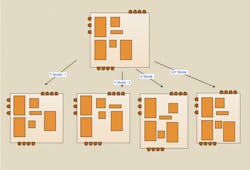Will AI Help Design Your Next Product?
Machine-learning (ML) and artificial-intelligence (AI) models based on deep neural networks (DNNs) are being exploited in a plethora of applications from voice analysis in the cloud for smart speakers to identifying objects for self-driving cars. Many of these applications employ multiple models that perform different types of identification and optimization chores.
But consumer and business applications aren’t the only places where AI/ML is coming into play. AI/ML software-development kits allow designers to incorporate these technologies into their own products, and tool developers are integrating them into their solutions so that the compiler you’re using might have an AI/ML model or two tuning your next design.
Cadence’s Cerebrus Intelligent Chip Explorer is one example of a software tool that’s taking advantage of AI/ML models to improve the output of the tools, as well as speed up their performance. Chip design is one of the most challenging hardware design chores that’s become even more complicated with single chips now housing billions of transistors. In fact, Cerebras Systems’ Waferscale Engine (WSE) incorporates trillions of transistors.
Cerebrus employs machine learning for improved power, performance, and area (PPA) determination as well as automated floorplan exploration (see figure). The AI/ML support is used more as a digital assistant to augment a designer’s choices by running multiple design options to find the best solution.\
Xilinx’s latest Vivado ML Edition takes a similar approach to improving FPGA layout. The intelligent design runs (IDRs) use a number of different ML models to improve things like timing closure. The gain in quality of results (QoR) for projects evaluated by Xilinx was 10% on average, with some solutions improving by over 50%.
AI/ML will continue to crop up in more tools. However, in conventional language compilers like gcc or LLVM, it’s made fewer inroads because such compilers already have a good deal of optimization implemented by design.
AI/ML technology continues to evolve as are the applications where this technology can be used. Even if you can’t take advantage of it in your application, you may still be doing so with the tools you employ to create it.
About the Author
William G. Wong
Senior Content Director - Electronic Design and Microwaves & RF
I am Editor of Electronic Design focusing on embedded, software, and systems. As Senior Content Director, I also manage Microwaves & RF and I work with a great team of editors to provide engineers, programmers, developers and technical managers with interesting and useful articles and videos on a regular basis. Check out our free newsletters to see the latest content.
You can send press releases for new products for possible coverage on the website. I am also interested in receiving contributed articles for publishing on our website. Use our template and send to me along with a signed release form.
Check out my blog, AltEmbedded on Electronic Design, as well as his latest articles on this site that are listed below.
You can visit my social media via these links:
- AltEmbedded on Electronic Design
- Bill Wong on Facebook
- @AltEmbedded on Twitter
- Bill Wong on LinkedIn
I earned a Bachelor of Electrical Engineering at the Georgia Institute of Technology and a Masters in Computer Science from Rutgers University. I still do a bit of programming using everything from C and C++ to Rust and Ada/SPARK. I do a bit of PHP programming for Drupal websites. I have posted a few Drupal modules.
I still get a hand on software and electronic hardware. Some of this can be found on our Kit Close-Up video series. You can also see me on many of our TechXchange Talk videos. I am interested in a range of projects from robotics to artificial intelligence.


